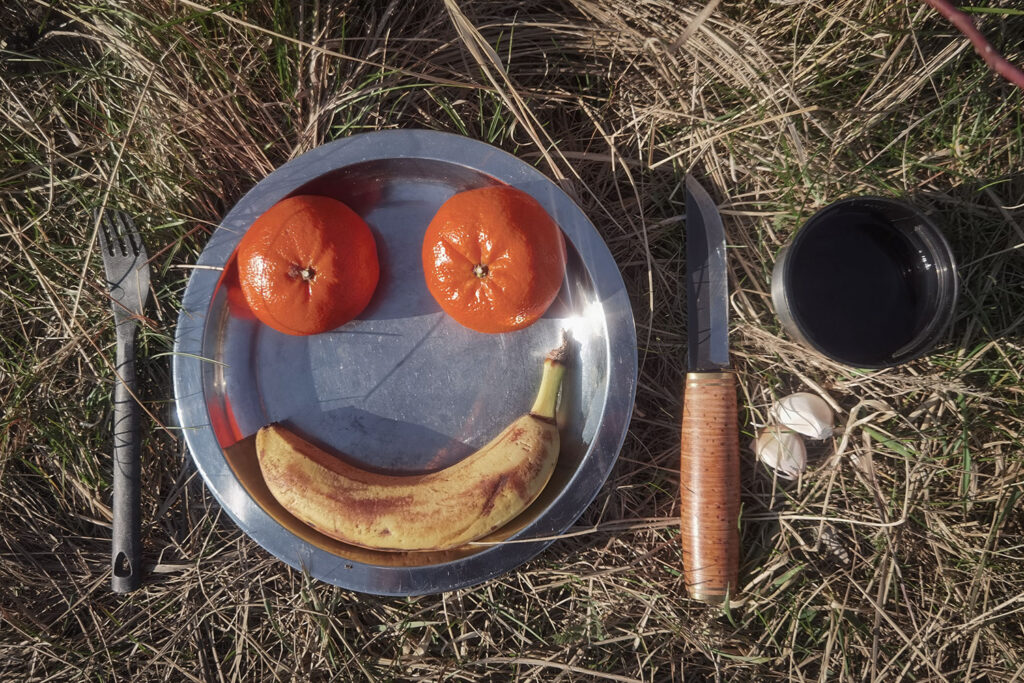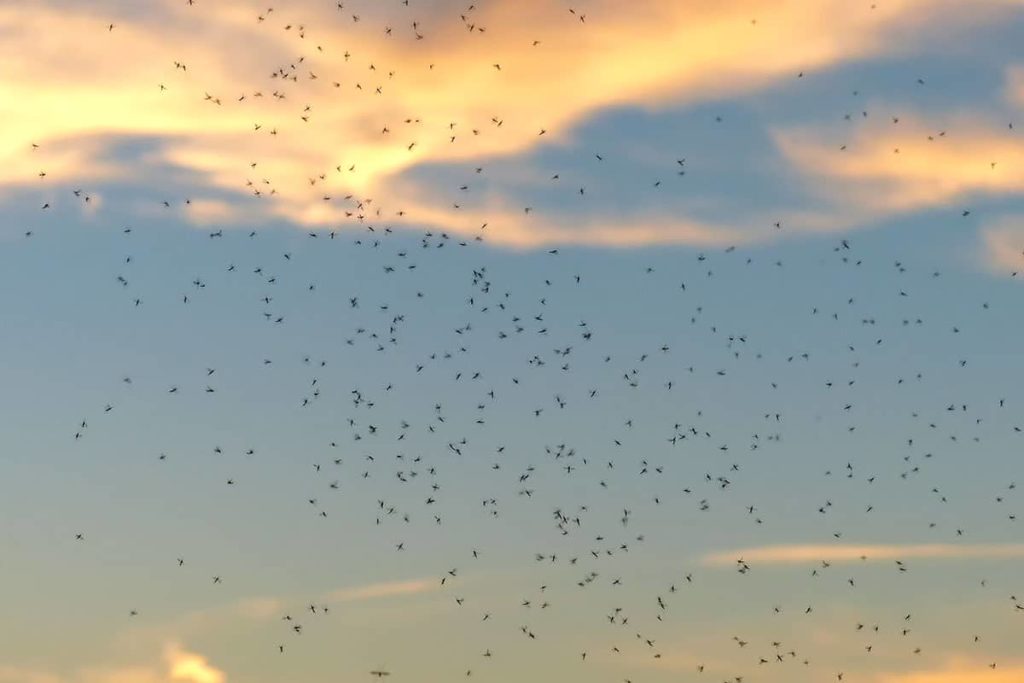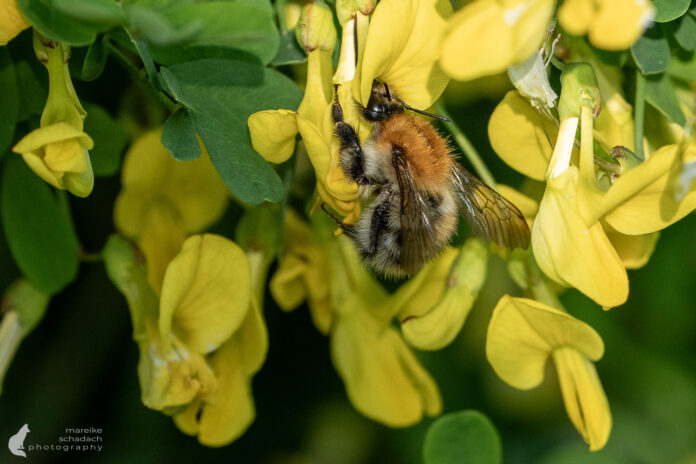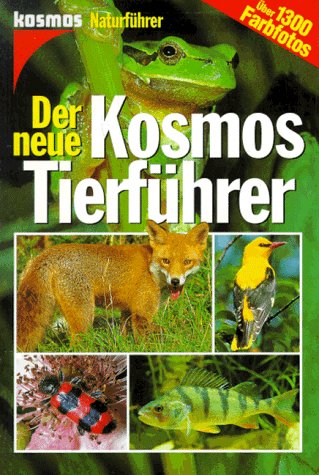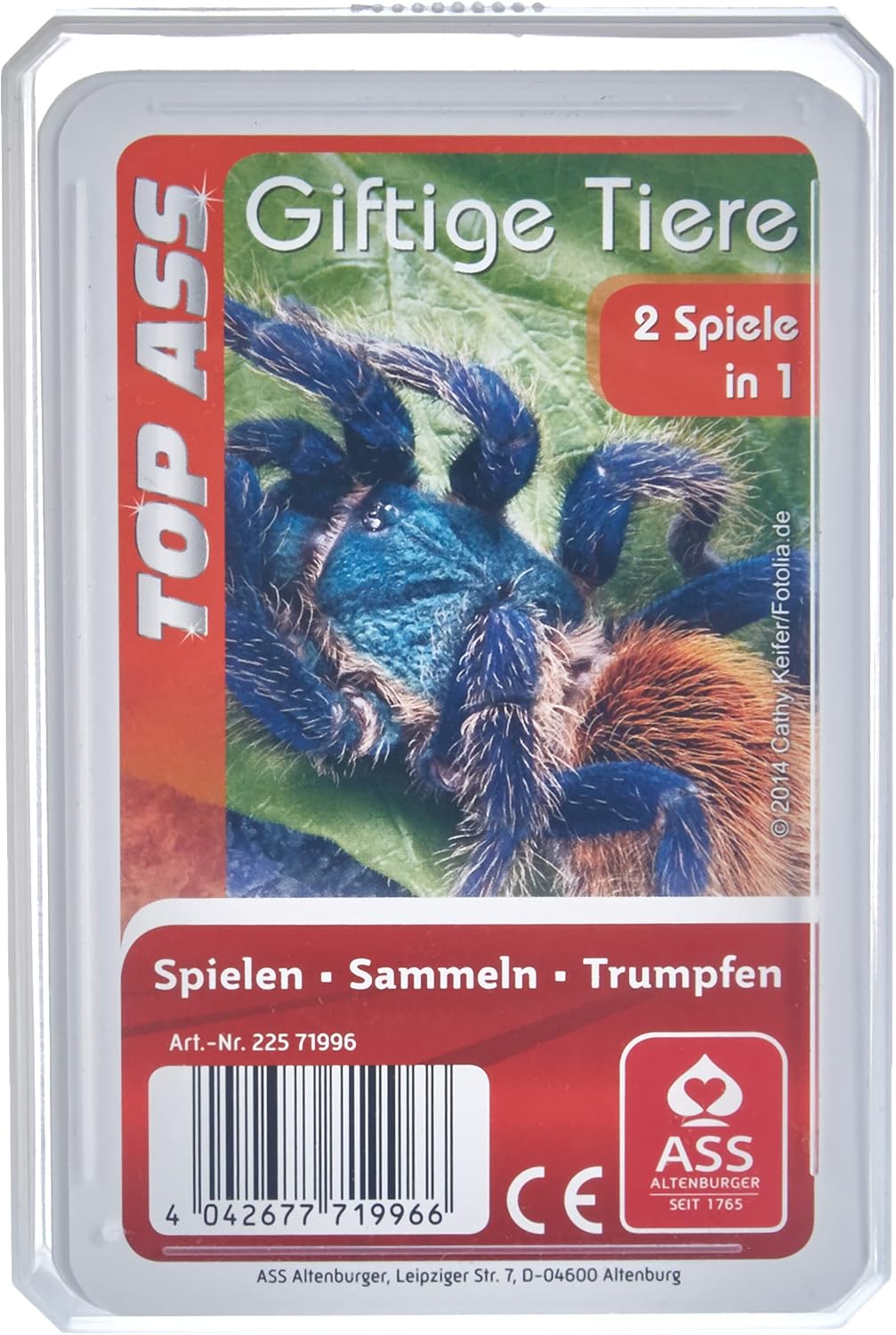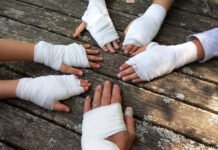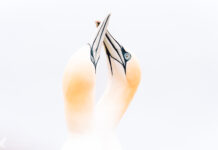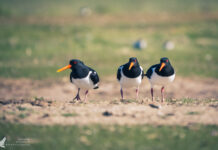Germany. Recently, I caught myself out: I know more about poisonous animals in the jungle than I do about poisonous animals in my home country of Germany. But are there any poisonous animals here at all? In fact, there are quite a few. Germany's diverse landscape offers suitable habitats for a wide variety of animals, including poisonous ones. Some introduced species also find a place where they can reproduce undisturbed. In addition, there are numerous other poisonous animal species in Europe (this will be a separate article), for which the ongoing climate change is increasingly opening the doors. It is only a matter of time.
Unassigned, unpaid advertising. The article contains affiliate links.
Better to learn before than suffer afterwards!
So what does this mean for us who like to be out and about? Clearly, we need to inform ourselves. We need to be proactive. The same applies when we travel to another country. Researching poisonous or dangerous animals - and also poisonous plants - is part of planning a trip. And we have to do this again and again, because our world is changing.
In the following article, I have compiled information about the poisonous animals currently found in Germany, possible symptoms after a bite, sting, or other contact, and the most common first aid measures. This basic knowledge should help you get started with your own in-depth research before your tour or trip. From here on, it's up to you to build up your own knowledge and skills and thus expand your own comfort zone.
I wrote this article as a follow-up to a trip to Indonesia. The night-time encounter with a huge spider in my tent and a poisonous green snake (which luckily wasn't in my tent) left a lasting impression. At the time, I had no idea what I would have done if I had been bitten. This ignorance didn't feel good, and will definitely not happen to me again.
For further learning and practical training, I can recommend the Wilderness First Aid courses at the Guide Academy Europe and the website from San Erlangen. If you are out and about with your dog, you will find lots of information on the First Aid for Dogs website. If you know what a bite looks like and how first aid works, you can act quickly in an emergency and prevent worse things from happening – whether to yourself or to fellow hikers.
Haftungsausschluss. Die Inhalte dieses Artikels sind ausschließlich zu Informationszwecken bestimmt und stellen in keiner Weise einen Ersatz für eigene tiefergehende Recherche, professionelle Beratungen oder Erste-Hilfe-Kurse dar.
How do you avoid being bitten or stung by poisonous Animals?
There are a few strategies to avoid coming into contact with animal venom. First of all: learn what the animal looks like, how it behaves, and where it lives.
- Don't touch animals, don't stalk them, don't harass them
- Don't reach out blindly or walk barefoot anywhere
- Keep your tent and bags closed
- Don't lay your clothes on the ground
- Shake out your shoes and clothes before putting them on
- Sturdy shoes, long clothes
- Mosquito nets also protect you from poisonous animals
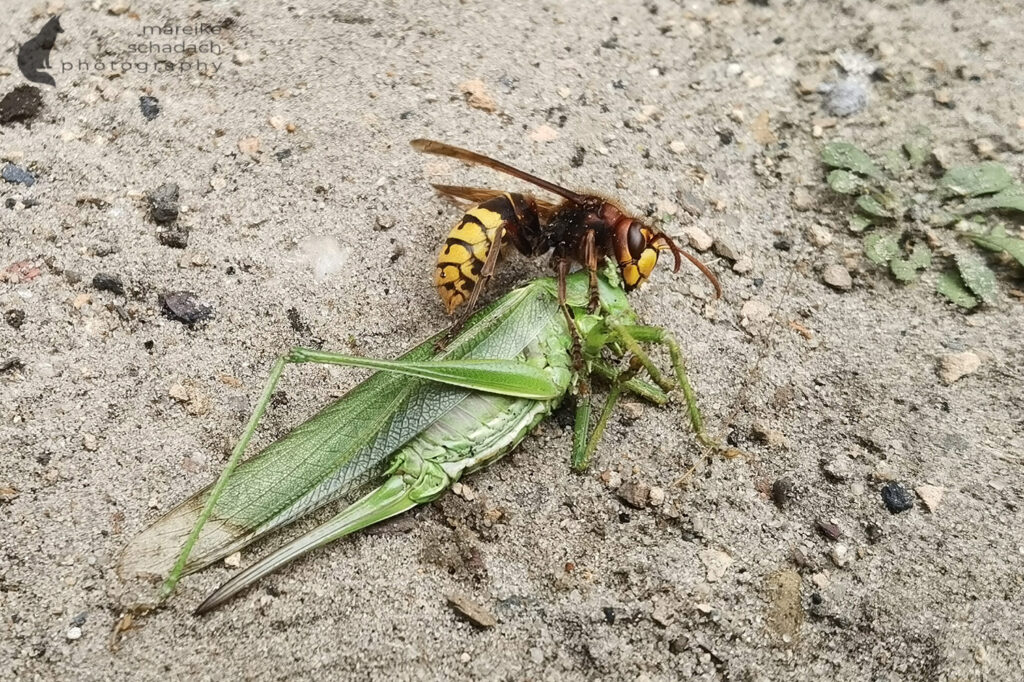
Poisonous Snakes in Germany
Germany is home to two venomous snakes, the adder and the asp. For most people, a bite is not life-threatening, but anyone affected should seek medical help as soon as possible. Children, the elderly, pregnant women, and sick people often have more severe reactions, as do people who have been bitten on areas of the body other than the arms or legs.
In individual cases, people can have an allergic reaction to the injected proteins and suffer a life-threatening anaphylactic shock. Medications such as ACE inhibitors or beta blockers can aggravate a possible allergic reaction to the snake venom and trigger an allergic shock.
Dogs are particularly at risk because they like to sniff in bushes or piles of stones, which is where snakes often rest. A bite can be life-threatening for them if it is not recognized and dealt with quickly.
Adder
- Appearance: The adder grows up to 90 cm long and usually has a dark zigzag pattern on a lighter background, but it can also be completely black.
- Habitat: Moors, meadows, forest edges. The preferred habitat is cool and damp. There must be sufficient hiding places, sunny spots and shade from the wind. It is particularly active in the rain and on hot and humid days.
- Effects: The venom of the adder destroys tissue, breaks down blood, and leads to coagulation disorders. A bite is rarely life-threatening for healthy adults, but it can be painful and cause strong reactions. Bites can be dangerous in the event of an allergic reaction or for children, as well as sick and elderly people. Around 30% of bites are so-called dry bites where no venom is released. Only 10-15% of the bites registered each year are classified as serious. Defensive bites often only use half the amount of venom, in contrast to prey bites. Around 10-15 % of the bites registered each year are classified as serious
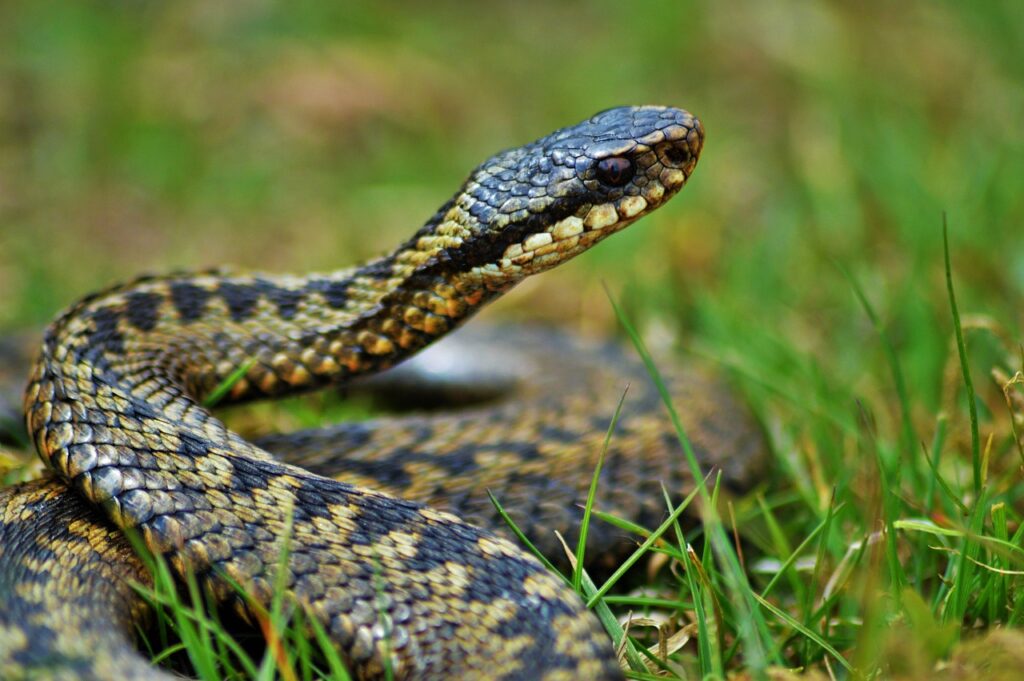
Asp viper
- Appearance: Similar to the adder, length up to 70 cm. Their coloration varies between light grey, brown, and black depending on their sex and living conditions. A darker, wavy band or zigzag pattern on the back.
- Habitat: Very small populations in the southern Black Forest. The Aspis viper is extremely thermophilic and prefers warm, dry, and stony habitats such as quarries or boulder fields, or gravel areas on slopes or riverbanks with a more southerly orientation.
- Effects: Its venom is similar to that of the adder, but stronger and slightly neurotoxic.
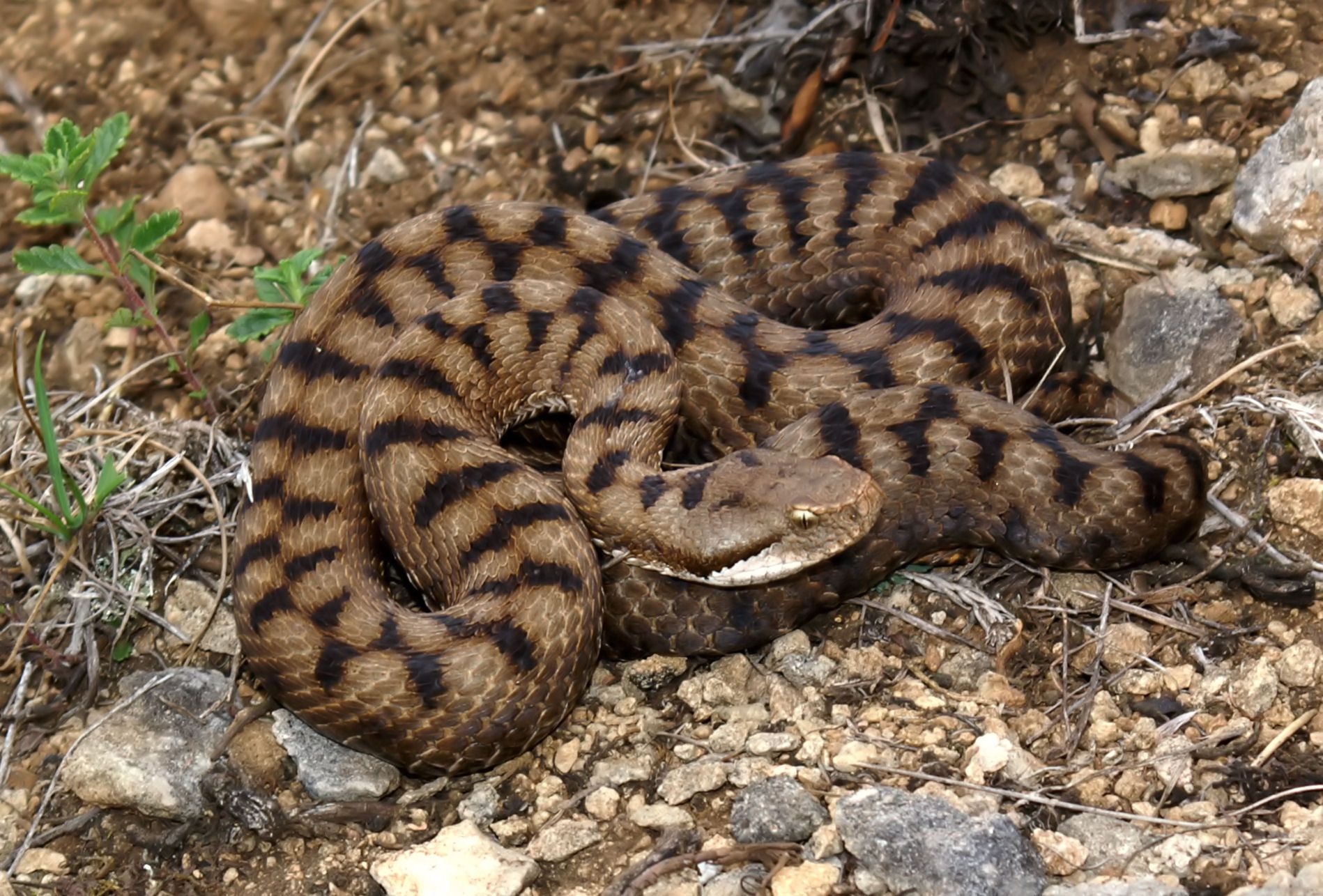
Possible Symptoms after a Bite from an Adder or Aspis Viper
- Mild symptoms: severe pain, swelling at the bite site, nausea, vomiting, increased pulse rate.
- Moderately severe symptoms: swelling spreads, edema, inflammation and thickening of the lymph nodes and lymph channels, diarrhea, pallor, drop in blood pressure, cramp-like pain in the abdominal area.
- Severe symptoms: Swelling can affect the whole body, repeated circulatory collapse, bluish skin discoloration, clouding of consciousness, unconsciousness and coma
Most common First Aid Measures
- Immobilize the bite site and keep it elevated
- Avoid physical exertion to slow the spread of the venom
- Remove tight-fitting clothing, jewelry, etc. (due to possible swelling)
- DO NOT cool the bite site, DO NOT cauterize, DO NOT suction, DO NOT cut open, DO NOT bandage, DO NOT pressure bandage!
- Drink plenty of water.
- If necessary, use any allergy medication available to the bitten person
- Get medical help as soon as possible
- Note the time of the bite
Sources: e.g. deximed.de, Snakes in Germany
The Section 39 of the Federal Nature Conservation Act (BNatSchG) places wild animals under general protection. Accordingly, it is prohibited to deliberately disturb wild animals or to catch, injure, or kill them without reasonable cause, as well as to impair or destroy wild animal habitats without reasonable cause. Section 44 BNatSchG describes further rules for specially protected species. Which animals these are in Germany can be found in Annex 1 of the Federal Species Protection Ordinance (BArtSchV) (the oak processionary moth is considered a pest and is not protected). In this context, it is also interesting to take a look at the catalog of fines on the subject of animal protection. There are not only figures here, but also interesting articles to read.
Poisonous Spiders in Germany
In Germany, spider bites are very rare and generally harmless. There is no native spider whose bite would be life-threatening for healthy people, but some can cause unpleasant symptoms, similar to a bee or wasp sting. If you have allergies or an immune deficiency, you should be more careful and consult a doctor if necessary.
Time and again, scorpions, spiders, or other creatures enter Germany unnoticed in holidaymakers' luggage or, for example, in banana boxes or via the plant trade. In this way, new, sometimes highly poisonous species can also colonize Germany. Even the black widow has already arrived in Germany on a cargo ship. You simply have to remain vigilant and keep yourself informed.
Yellow sac spider – Neozoon
- Origin: South-eastern Europe, spreading northwards due to climate change
- Appearance: The front body of the up to 1.5 cm large spider is plain red-orange, the abdomen is yellowish to olive green in color.
- Lives in dry, warm meadows with tall grass, especially in southern regions.
- Venomous effect: similar to a bee sting. Rarely: Blistering or necrosis.
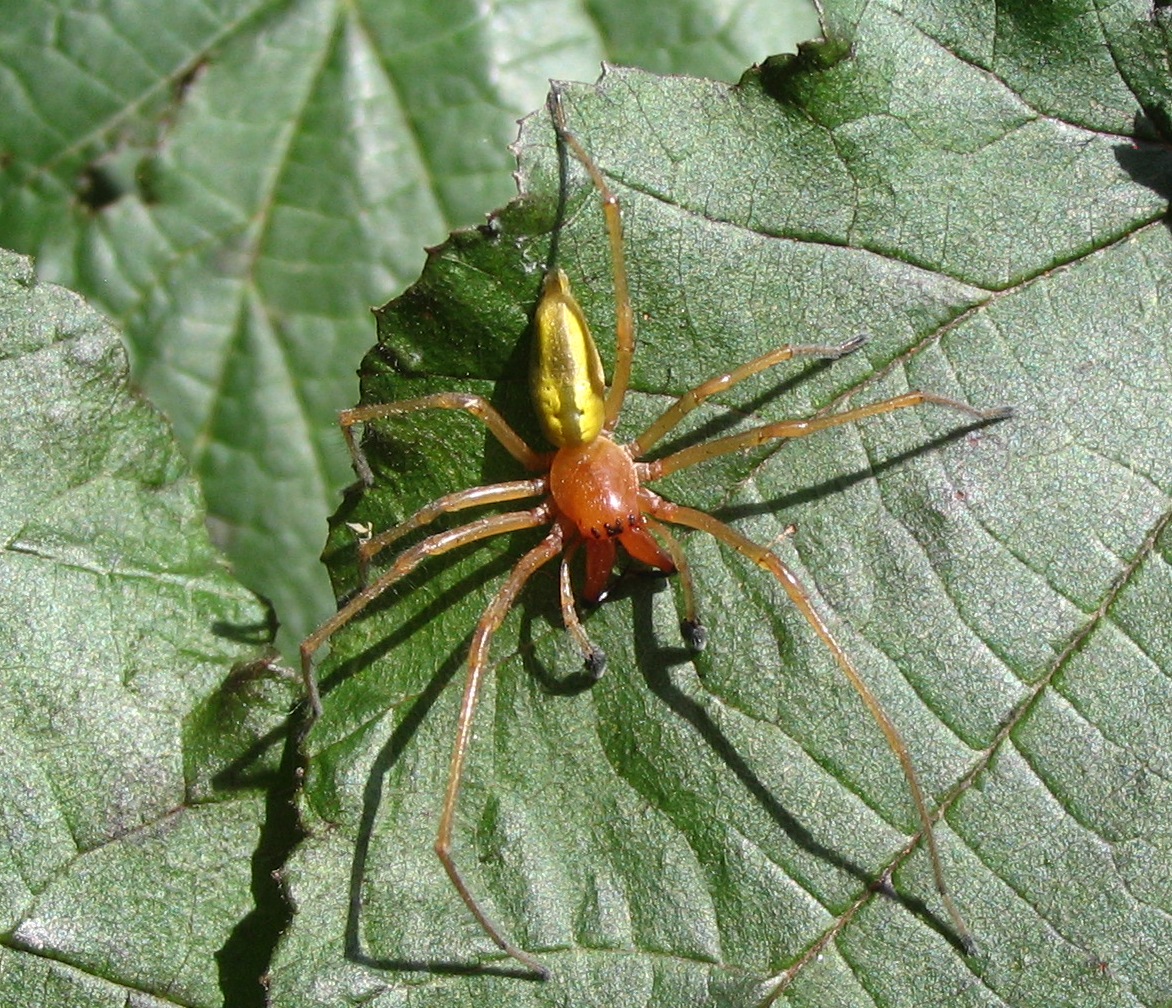
Garden spider
- Very common spider in gardens and forests.
- Appearance: Between 5 and 18 mm in size. The body consists of a head, thorax, and abdomen, and is light brown, reddish brown to black in color. Light spots on the abdomen have the shape of a cross
- Venomous effect: Only local reaction in sensitive individuals (itching, slight swelling).
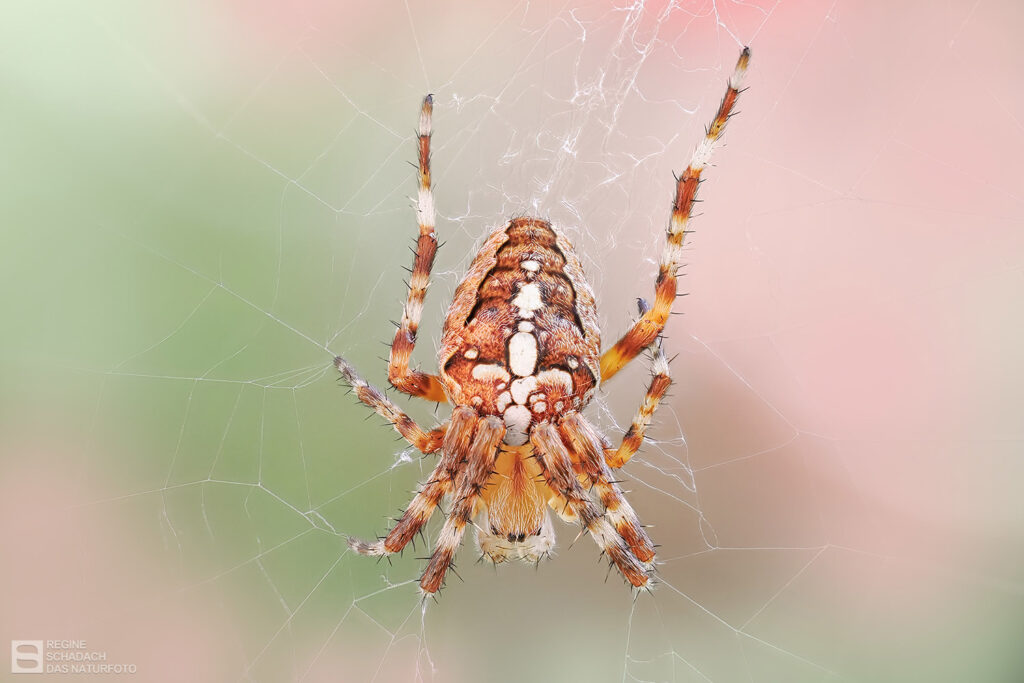
Nosferatu spider – Neozoon
- Origin: originally the Mediterranean region, since the 2000s increasingly in Germany, especially in homes in southwest Germany.
- Appearance: With outstretched legs up to 5 cm long. The body is yellowish-white in color, the legs yellow-grey to dark grey with black stripes.
- Venomous effect: comparable to a bee sting.
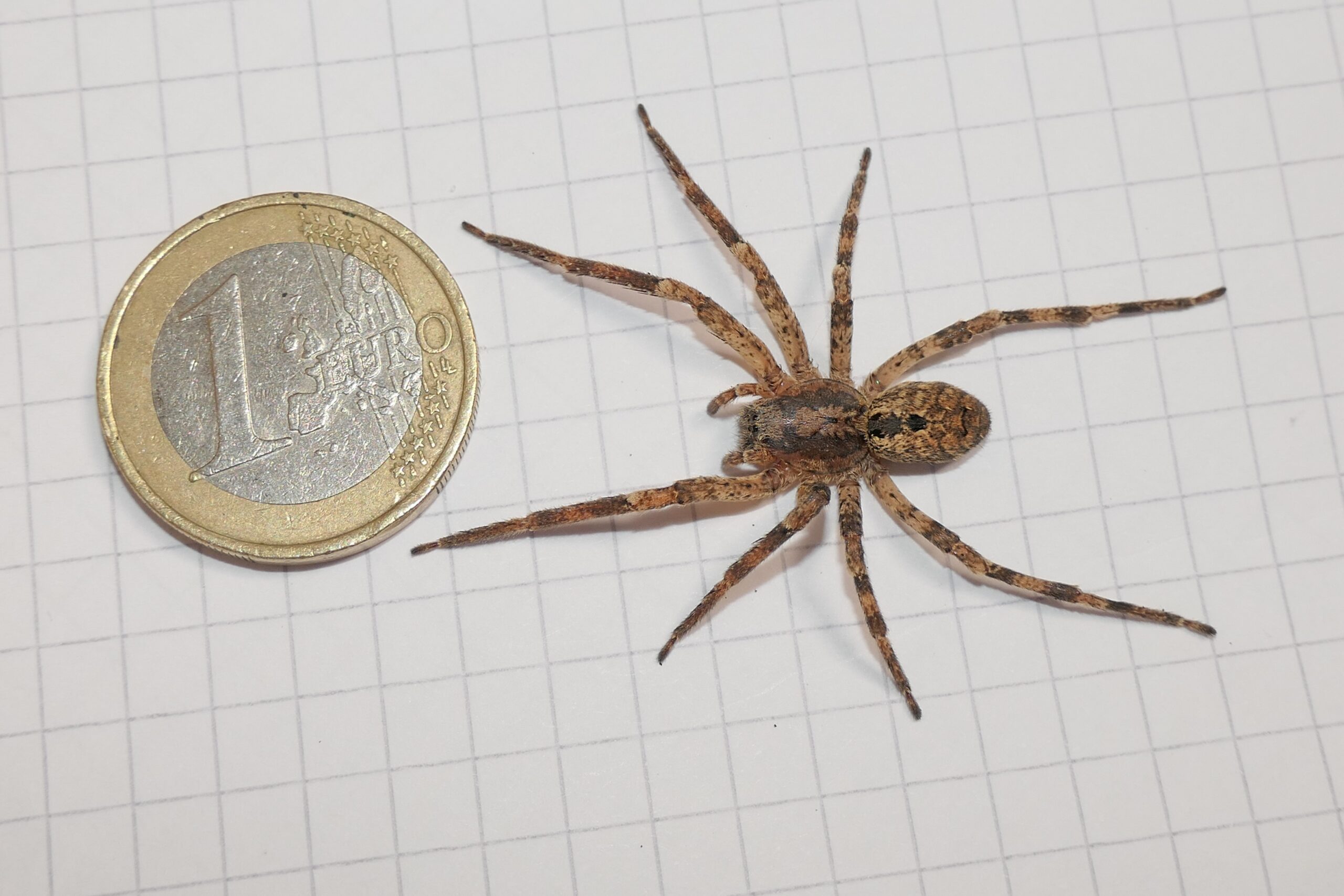
Brown recluse spider – Neozoon
- Origin: Midwest and southern USA
- Appearance: up to 2 cm in size, brown or yellowish, and a dark line across the hind body
- Giftwirkung: in den meisten Fällen lediglich zu rote Pusteln. An der Bissstelle kann das Gewebe absterben (Nekrose). Weitere mögliche Symptome: Kopfschmerzen, Übelkeit, Erbrechen, Krämpfe und Muskelschmerzen. Auch Todesfälle kommen vor.
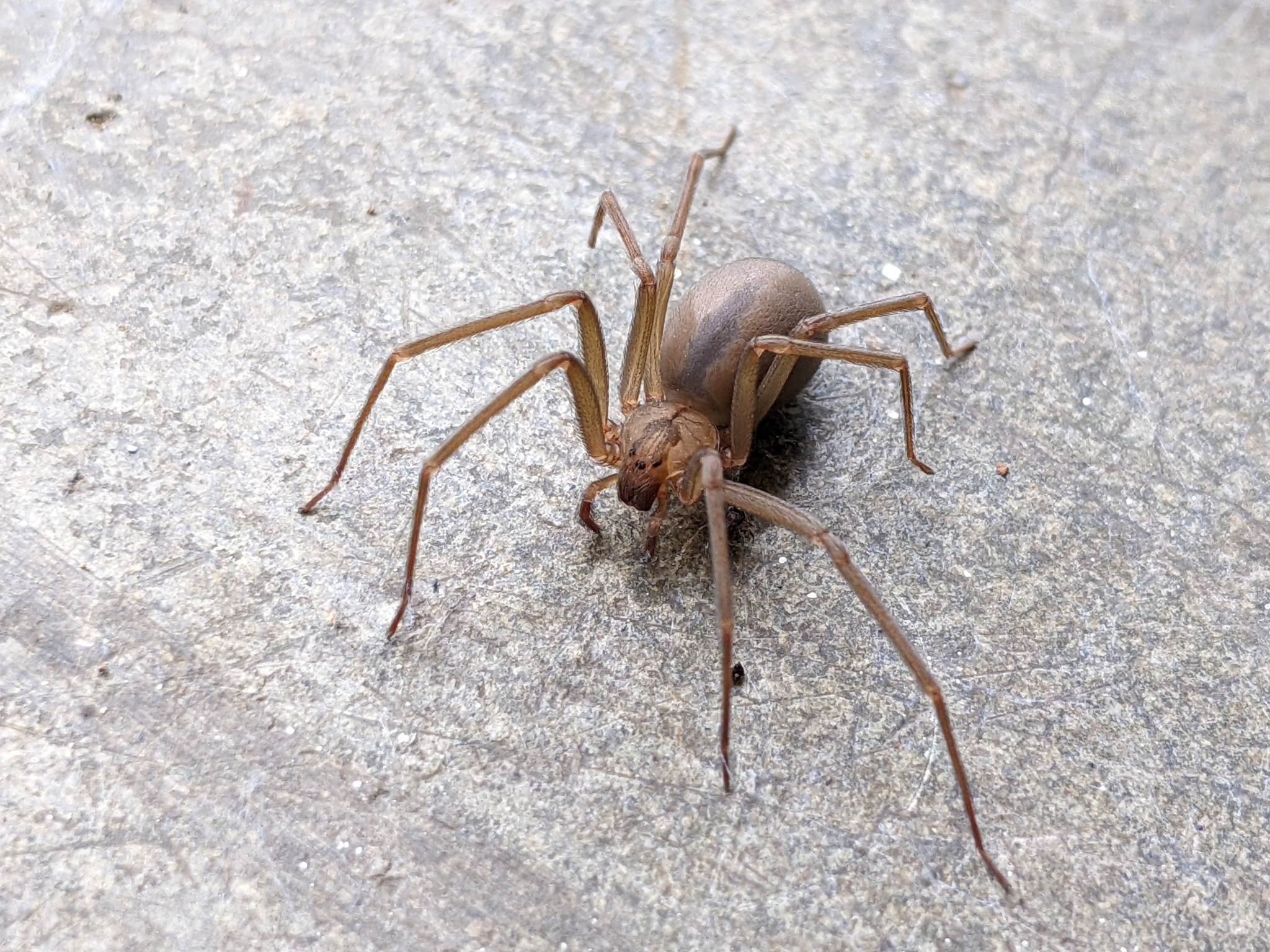
Possible Symptoms after a Spider Bite in Germany
- Local: Stinging pain at the bite site (short-lived), redness, swelling, itching, or burning. Rarely: Blistering or small necrosis in the case of a thorn finger bite.
- General: Headache, nausea, muscle or limb pain, fever-like symptoms (usually only with allergic or psychogenic reaction - “spider fear”)
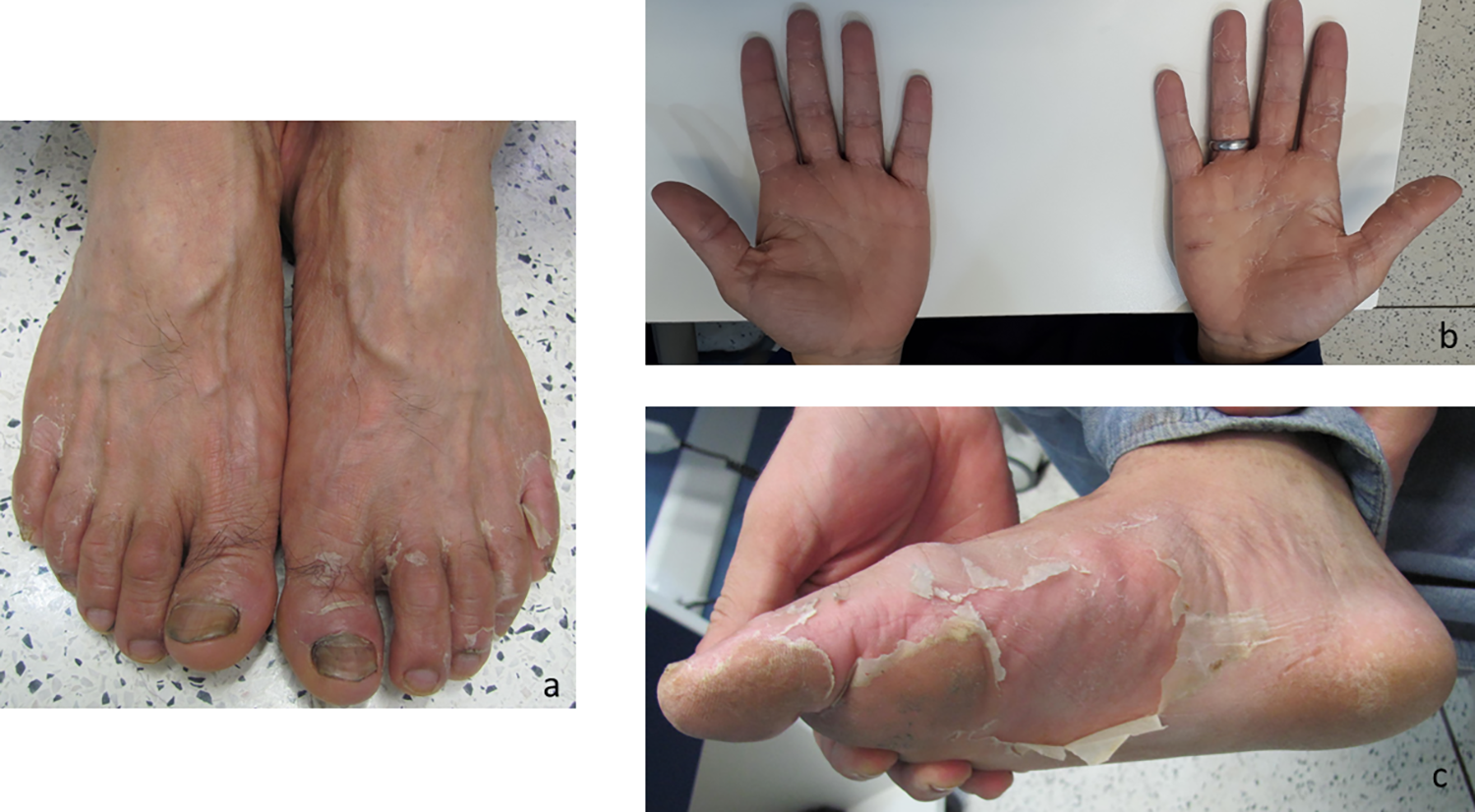
Ceila M. S. Malaque, Christina T. G. Novaes, Roberta O. Piorelli, Jose Y. Risk,Jefferson C. Murad, Amanda N. Lara, Cristiana C. Virgulino, Karina T. Miyaji, Marcelo L. Santoro, CC BY 4.0 https://creativecommons.org/licenses/by/4.0, via Wikimedia Commons
Most common First-Aid Measures Spider Bite
- Clean wound with soap and water or disinfectant
- Cool, e.g. cool pack or cold cloth, 10-15 minutes
- Observe bite - document swelling and redness
- Keep calm - in most cases the bite heals without any problems
- See a doctor if: Persistent or increasing pain/swelling, signs of infection (pus, severe redness, fever), allergic reactions (shortness of breath, circulatory problems, swelling of face or neck)
Source: e.g. Medinstruct
Poisonous Insects in Germany
Insect bites pose serious health risks, especially for allergy sufferers. In addition, climate change is bringing another issue into focus: more and more new, potentially dangerous insect species are migrating from more southern regions and establishing themselves in this country. The same applies to spiders and other animal species. Alongside poisonous plants, insect bites and stings (including mosquitoes and ticks) are one of the biggest threats to our outdoor activities.
Wasps
Around 20 deaths from bee, wasp, and hornet stings are reported in Germany every year. For allergy sufferers, a single sting can trigger an anaphylactic shock and be life-threatening! It is therefore important to know and be able to apply the symptoms and first aid measures, to be aware of any allergies your fellow hikers may have, and to know where to keep an EpiPen.
Wasp-like insects (wasps, bees, hornets, bumblebees, neozoon: Asian hornet) all have similar but not identical venoms. Their sting venom contains a mixture of proteins, enzymes, and biochemically active substances that trigger pain, inflammation, and in some cases allergic reactions. The immune system does not react to the venom itself, but to certain protein components.
Possible Symptoms of Stings
- Normal reaction: severe swelling at the injection site, pain, burning or severe itching
- Allergic reaction: swelling of the face, neck and hands, nausea, difficulty swallowing, skin rash all over the body (hives), dizziness, weakness.
- Anaphylactic shock: acute shortness of breath, drop in blood pressure, rapid heartbeat, in the worst case, organ failure

Most common First Aid Measures
- Scrape away the stinger, if still present. When pulling it out, the venom gland remaining on the sting can be squeezed and further venom injected into the sting.
- Stay calm, reduce movement
- Cool externally (e.g. with ice pack, damp cloth - 10-15 minutes)
- Sting in the throat: cool internally by drinking cold water or sucking ice cubes (for conscious patients)
- Home remedy: apply a slice of onion, honey, aloe vera, vinegar or lemon water, crushed ribwort
- Antihistamine gel or cortisone ointment for itching; take an antihistamine (if available and tolerated)
In case of allergic reactions:
- Call an emergency doctor (112)
- Keep the person sitting upright (shortness of breath) and loosen tight clothing
- Use an adrenaline auto-injector (e.g. EpiPen) or support the stung person when using it
- Place the person in the recovery position if unconscious
Source: Malteser
Oil beetle
- Occurrence: Dry, flower-rich meadows and forest edges
- Poison: Cantharidin - a strong skin and mucous membrane poison. Beetles do not bite or sting, but release their toxins through the skin. In case of danger, oil beetles can secrete small droplets on their leg joints that look like oil droplets and serve as a defense against predators.
- Effect: Redness, blisters, and severe irritation or inflammation can occur on contact with the skin. It helps to wash your hands thoroughly after contact.
Interesting to know: Cantharidin, obtained from the oil beetle species Spanish fly, was already used as a sexual enhancer in ancient times. It irritates the urinary tract, which can cause an erection, but it does not increase sexual desire. It can lead to prolonged lovemaking but also to a painful permanent erection, liver poisoning, circulatory collapse, and kidney failure. This is because Spanish fly is easily overdosed. Just 30 mg is fatal, and the small death of orgasm can easily be followed by the big death of cantharidin.
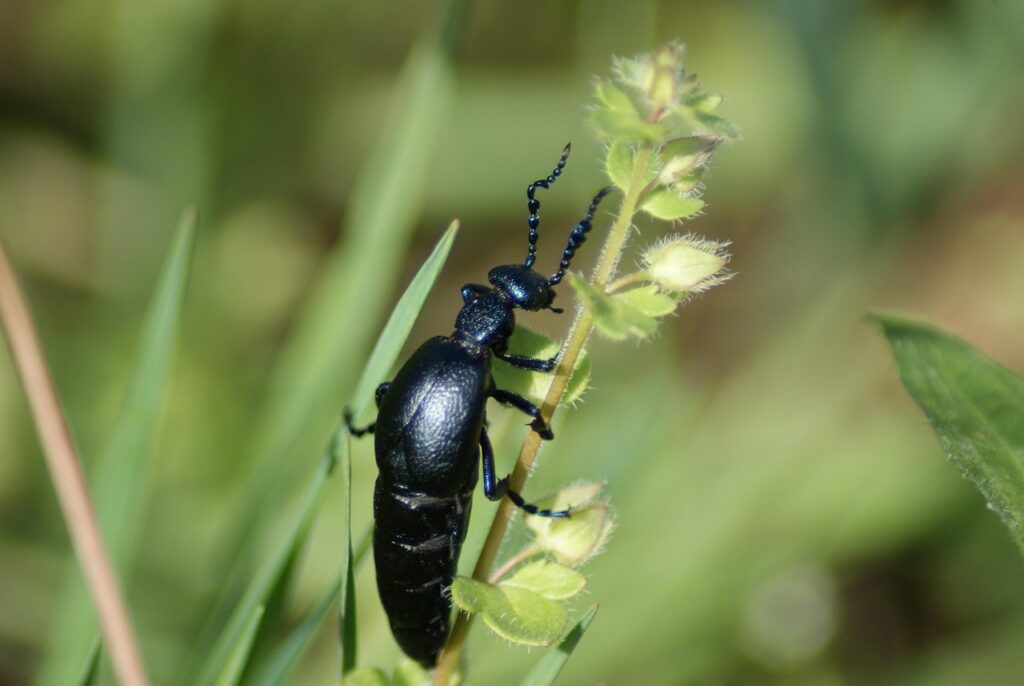
Symptoms after swallowing an oil beetle
After ingestion, the cantharidin contained in the oil beetle can cause severe symptoms of poisoning. Typical symptoms are
- Burning in the mouth and throat, nausea, vomiting, abdominal cramps, bloody diarrhea, dizziness, circulatory problems
- In severe cases: Kidney failure
Most common First Aid Measures
- Do not induce vomiting!
- Rinse out mouth, but do not give milk or food.
- Call for medical help immediately
- Save beetle remains (if possible) for later identification.
- Keep calm and keep the affected person calm to avoid circulatory strain.
In Germany, there are no highly poisonous ant species as known from tropical regions. Nevertheless, there are some native or introduced species whose bites or chemical secretions can be irritating or allergenic to humans. Future risks include the immigration of new, tropical species such as the pharaoh ant and the fire ant. Climate change increases the likelihood that these extremely painful, stinging, and allergenic species will also gain a foothold in Germany.
Red wood ant
- Occurrence: Forests throughout Germany.
- Behavior: Aggressive in nest defense.
- Toxicity: No poisonous sting, but it injects formic acid into the bite wound.
- Danger to humans: Irritation of the skin, allergic reactions in sensitive individuals. Scratched bites can lead to secondary infections.
Black trail ant
- Occurrence: Very common in gardens, parks and settlements.
- Toxicity: Hardly dangerous. Can bite, but only secretes small amounts of formic acid.
- Danger to humans: Mostly harmless, occasionally itching on sensitive skin.
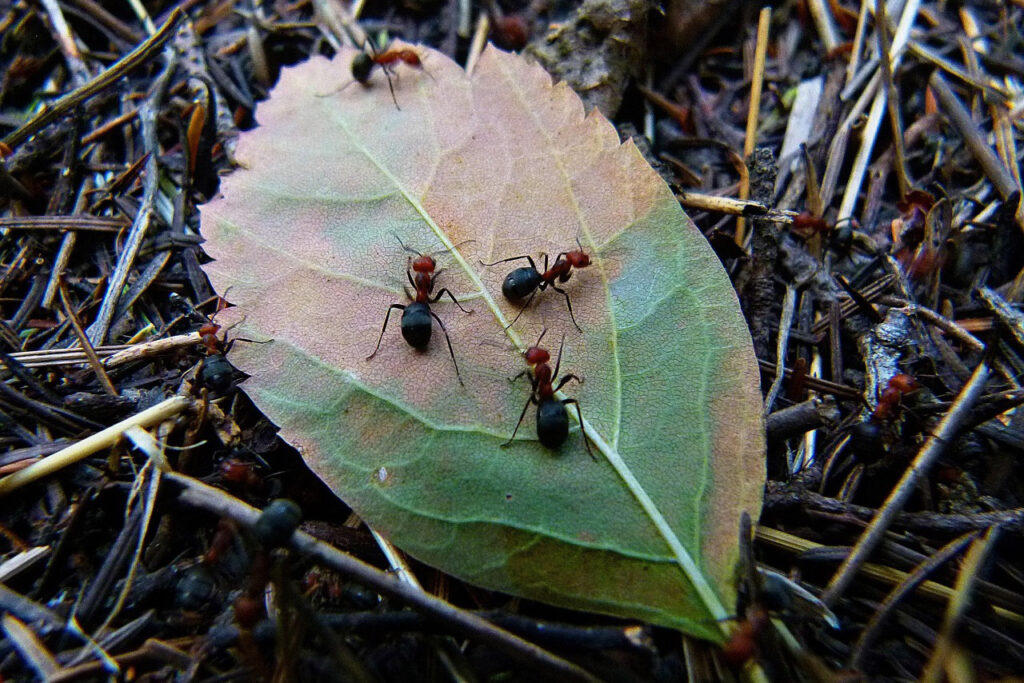
Oak processionary moth
Anyone out and about in parks and forests will be familiar with the signs and information boards warning of the oak processionary moth. This refers to the caterpillar of a gray butterfly with a wingspan of 25 mm. Only the caterpillars are dangerous to humans. These grow up to 5 cm long and have a dark, broad dorsal line and white hairs. They live in nests that look like spider webs. In the evening and at night, they move in colonies in long processions across the trees or along the ground in search of food. It is best not to get too close to these little animals. A picnic under an oak tree? It's worth taking a close, scrutinizing look upwards.. Sie leben in Nestern, die wie Spinnweben aussehen. Abends und nachts wandern sie in Kolonien als lange Prozessionen auf der Suche nach Nahrung über die Bäume oder auch am Boden entlang. Diesen Tierchen kommt man besser nicht zu nahe. Ein Picknick unter einem Eichenbaum? Da lohnt sich ein genauer, prüfender Blick nach oben.
- Origin: Originally in southern Europe, spread further north due to climate change
- Danger: The caterpillars carry microscopic hairs containing the nettle toxin thaumetopoein. These hairs break off easily, float in the air, and stick to skin, clothing, or animal fur. The stinging hairs remain poisonous for several years, even in old nests or on the ground.
- Occurrence: Especially in warm regions with many oak trees
Symptoms after contact with the stinging hairs
- Skin: Severe itching, wheals, redness (similar to hives), burning, rash (usually after 1-8 hours)
- Respiratory tract (after inhalation of the hairs): Irritating cough, sore throat, difficulty swallowing, shortness of breath, bronchitis-like symptoms, in severe cases: Asthma attacks
- Eyes & mucous membranes: redness, tearing, burning, conjunctivitis
- Allergic reactions possible: swelling (e.g. lips, face), fever, circulatory problems. Very rare: anaphylactic shock
Most common First Aid Measures
- Change clothes immediately - preferably take them off outside, then take a shower
- Shower skin thoroughly, wash hair - do not rub! (also irritates)
- Wash contaminated clothing separately
- Do not scratch to avoid skin damage and infection
- Antihistamine or cortisone ointment for severe itching
- In case of shortness of breath, eye involvement or allergic reaction: See a doctor immediately!

Mosquitoes and Ticks
Mosquitoes and ticks are not poisonous animals per se. However, as they can transmit a variety of sometimes serious diseases and as they are almost always present during outdoor activities, I have included them in my list.
Tropische Mücken wie die Asiatische Tigermücke und die Asiatische Buschmücke breiten sich aufgrund klimatischer Veränderungen zunehmend in Deutschland aus. Sie können gefährliche Krankheiten übertragen, wie etwa das Denguefieber, Chikungunya-, West-Nil- oder das Zika-Virus. Eine solche Vektorübertragung ist bislang in Deutschland nicht beobachtet worden, aber das Risiko steigt. Zecken können Borreliose und FSME übertragen. FSME ist die Abkürzung für Frühsommer-Meningoenzephalitis, eine Infektionskrankheit, die eine Entzündung von Gehirn, Hirnhäuten und/oder Rückenmark auslösen kann. Auch bei den Zecken gibt es Neozooen: die tropische Hyalomma-Zecke wurde inzwischen auch in Deutschland nachgewiesen. Sie gilt als potenzieller Überträger des Krim-Kongo-Fiebers, einer lebensbedrohlichen Viruserkrankung.
Good protection against mosquitoes and ticks will become even more important in the future. This is because vaccines are only available for TBE and dengue fever. Bites and stings can be avoided through prudent behavior, insect repellent, mosquito nets, and long clothing. Daily body searches for ticks and professional removal of bitten ticks helps to prevent Lyme disease, as the quicker a tick is removed, the lower the risk of infection. Lyme disease can be recognized by the characteristic “migratory redness”, a large, circular reddening of the skin that often occurs around the site of a tick bite. Flu-like symptoms may also occur. If Lyme disease or TBE is suspected, a doctor should be consulted as soon as possible.
The first thing to do with mosquito bites is to cool the bite site. This can be done with cold compresses, cooling pads, or ice cubes in a cloth. It is important not to scratch the area to avoid infection. Over-the-counter antihistamines can help with severe itching or swelling.
Poisonous Scorpions in Germany
Of the approximately 2,300 scorpion species known worldwide, only 50 scorpion species have a venom that can kill humans. The scorpions found in Europe are not among these very venomous species. Although the scorpions in Europe also have venom, a sting is not usually life-threatening. There are also scorpions in Germany that originally come from Italy - but these are rare, small, and harmless. It is quite possible that other species will be introduced to Germany in the future.
Italian Scorpion – Neozoon
- Appearance: About 3-5 cm in size, brown to black in color.
- Habitat: Individual occurrences in southern Baden-Württemberg, especially in warmer areas such as the Kaiserstuhl, Freiburg im Breisgau, Heidelberg (e.g. Philosophenweg, Schlossmauer), Karlsruhe, Rhine Valley, Moselle, and Middle Rhine Valley (e.g., around Koblenz, Boppard), Trier, and the surrounding area. The scorpion lives hidden in crevices, under loose bark, stones, or in cracks in walls, especially on warm, sunny walls and vineyards.
- Active at dusk or at night in warm weather.
- Sting present, but venom (neurotoxin) very weak - like an insect bite, only noticeable in sensitive people.
I haven't tried it myself yet, but scorpions are said to be easy to see at night with a UV lamp because they glow in UV light. The phenomenon is called biofluorescence. The outer skin of scorpions contains certain molecules that emit visible blue-green light when excited by short-wave, high-energy UV light. This glow is a kind of sun protection for them and may be used for orientation or as a lure at night.
Poisonous Amphibians in Germany
Some amphibian species in Germany have mild skin toxins (alkaloids, bufotoxins) that irritate the skin and, in very rare cases, can cause allergies or symptoms of poisoning in sensitive people. The secretion can irritate the eyes or mouth. Children in particular should wash their hands after contact with amphibians.
The bufotoxin system is common in many amphibians, such as the common toad. It mainly affects the nervous system and the heart of predators, e.g. birds or small mammals.
Fire salamander
- Poison: Produces the alkaloid samandarin in skin glands.
- Effect: Irritating to mucous membranes, causes cramps in animals, skin irritation and nausea possible in humans.
- Special feature: The glands are mainly located behind the eyes - the poison is released when threatened.
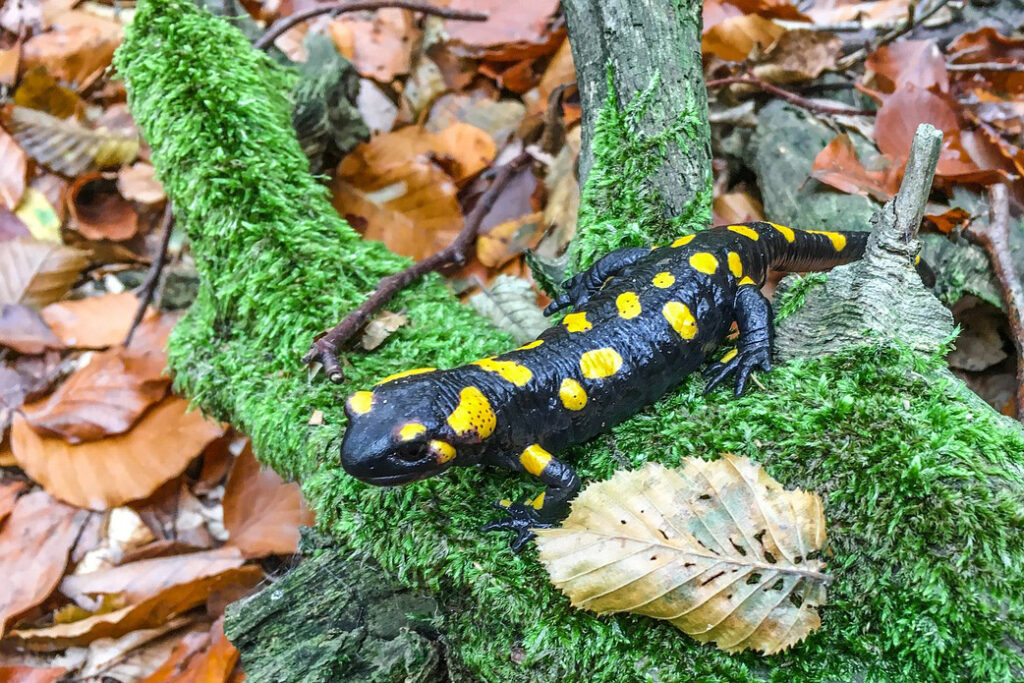
Toads - Yellow-bellied toad and Fire-bellied toad
- Appearance: Wart-like skin, brightly colored belly (yellow or orange with black).
- Venom: Skin secretion contains batrachotoxins (not to be confused with the highly toxic tropical variants).
- Effect: Skin and eye irritation on direct contact with the secretion.
- Defense: In case of danger, they show their belly in a defensive posture (“toad reflex”) to deter predators.
Common toad and Midwife toad
- Appearance of the common toad: Brown-grey toad with warty skin.
- Appearance midwife toad: Grey-brown, sometimes slightly olive-colored; often with dark spots, lighter underside. Eyes strikingly golden yellow with a horizontal pupil.
- Venom: Bufotoxins in skin secretions and from the ear glands behind the eyes.
- Effect: Irritation of the mucous membranes, bitter taste, can cause vomiting or drooling in pets such as dogs. They are harmless to humans as long as you wash your hands after touching them and avoid contact with your eyes or mouth.
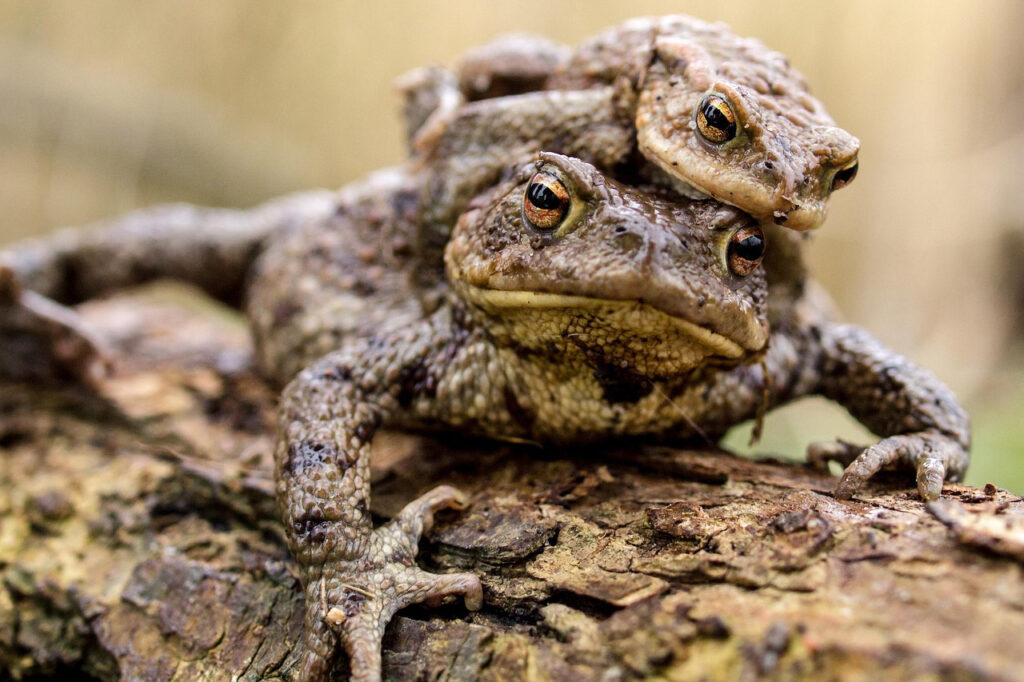
Possible symptoms of amphibian toxins
- In case of skin contact: Burning, itching, redness, slight swelling, irritation of the mucous membranes (eyes, mouth)
- If swallowed: Nausea, vomiting, abdominal pain, metallic/bitter taste, tingling in the mouth, in very rare cases: Circulatory problems, shortness of breath
Most common First Aid Measures
- Wash skin thoroughly with soap and water
- Flush eyes or mucous membranes (with clear water or eyewash solution)
- Do not rub!
- If swallowed: Rinse out mouth, possibly activated charcoal (if available)
- Consult a doctor if symptoms are severe
Poisonous Fish in Germany
Lurking well camouflaged in the sand is the most poisonous fish in Europe. The weever fish is found in shallow water, partly buried in the sand and therefore easy to overlook. If you come into contact with the Petermännchen, you will immediately feel severe pain, often followed by swelling that lasts up to 24 hours. But the sea scorpion can also sting unpleasantly with its dorsal fin spines. Sturdy bathing shoes offer the best protection.
Weever fish
- Appearance: Elongated, laterally flattened demersal fish with eyes on the top of the head, 15 to 53 cm long. They have a green-brown-yellowish coloration.
- Habitat: Sandy bottoms in the North Sea and western Baltic Sea
- Danger: Dorsal and gill cover spines with painful venom
- Symptoms: Severe pain, swelling, rarely circulatory problems

Sea scorpion
- Appearance: Up to 60 centimeters long, a demersal fish with a bulky head and large mouth
- Habitat: Primarily in the Baltic Sea, often near the shore, among rocks
- Danger: Dorsal fin spines with a slightly toxic secretion
- Symptoms: Pain, redness, relatively harmless – but unpleasant

Most common first aid measures for a weever or sea scorpion sting
- Remove the sting (not with bare fingers)
- Soak the wound under hot water (approx. 45°C; 15–30 minutes) – heat destroys the protein toxin and relieves the pain. For dogs, place a hot washcloth on the sting site if necessary.
- Disinfect, observe
- If you experience circulatory problems, severe swelling, or allergic reactions: See a doctor immediately!
Poisonous Freshwater Fish in Germany
There are fish species in Germany that have venom glands on their spiny fin rays: ruffe, perch, and zander. Their sting venom can cause local pain, swelling, redness, or mild inflammation, similar to an insect bite. The effect is not dangerous, but there is a risk of infection if the wound is not cleaned.
Caution when fishing and good wound care are important.
Poisonous Jellyfish in Germany
In German waters, compass jellyfish, moon jellyfish, and fire jellyfish can cause skin reactions. For healthy people, contact with the jellyfish found here is unpleasant but not life-threatening. The venom of the stinging cells can cause burning pain, redness, itching, and minor swelling. Allergy sufferers, children, or people with sensitive skin may experience more severe reactions.
Most common first aid measures for jellyfish contact
- Do not rub!
- Use salt water (not fresh water) to rinse.
- Vinegar helps deactivate stinging cells in some species (not all!).
- Carefully remove tentacle remains with tweezers or a credit card.
- In case of severe reactions: Seek medical attention!
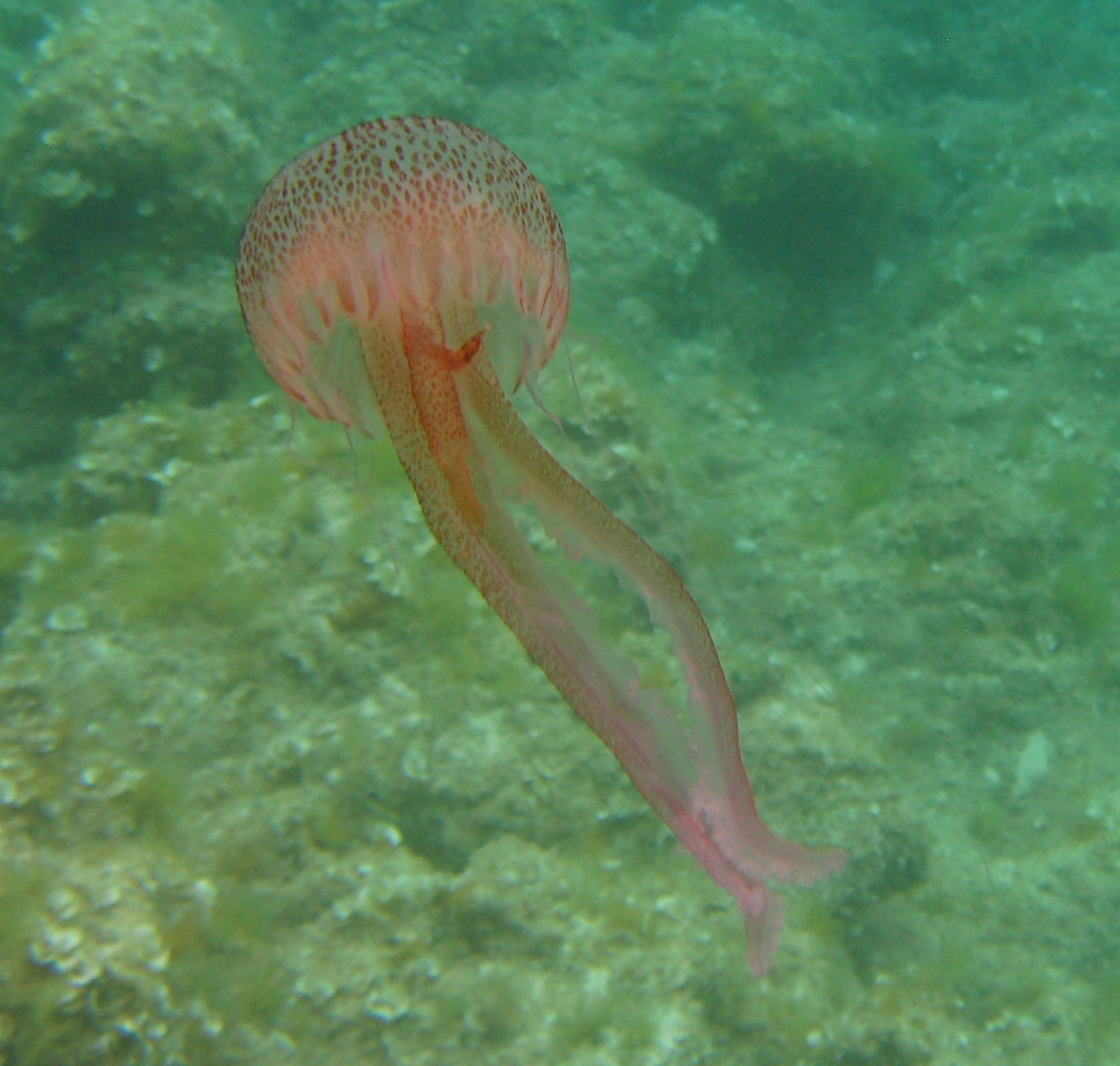
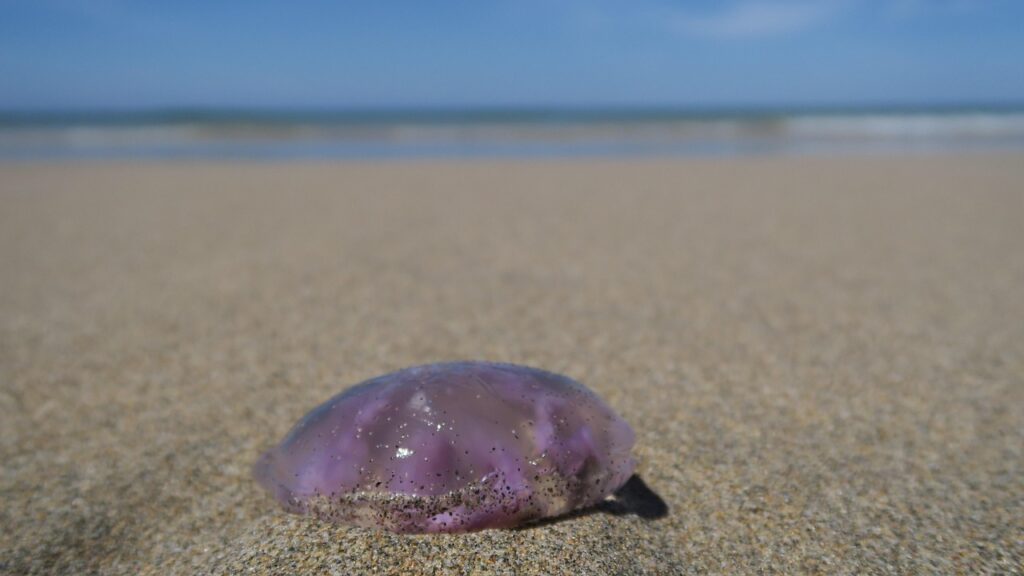
Book Recommendations about poisonous Animals and Animals in Germany
Want to know more about poisonous animals and our native animals in Germany? Then I can recommend these books (affiliate links).
You can order the books on Amazon by clicking on the images. If you purchase a product through an affiliate link, I receive a small commission, and you help me continue to fill Fernweh-Motivation with interesting articles. This doesn't increase the price of the product for you, and you're doing me a huge favor. As an Amazon Associate, I earn from qualifying purchases.
Want to know when there are new articles on my blog? Then follow me on Facebook, Pinterest or Instagram. I am also very happy if you share my article with your friends.
Recommendations for further Reading
Du bist gerne draußen unterwegs und achtest auf deine (und anderer Leute) Sicherheit? Dann interessieren dich ganz sicher auch mein Artikel zum Thema staying healthy on trekking tours sowie mein Artikel über midges in Scotland.
